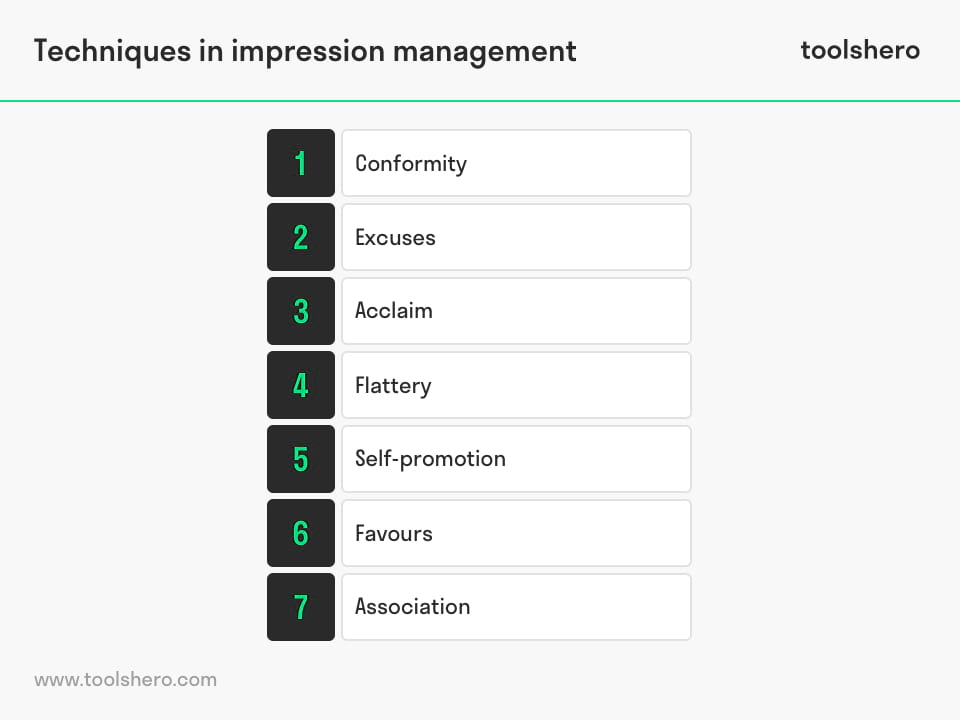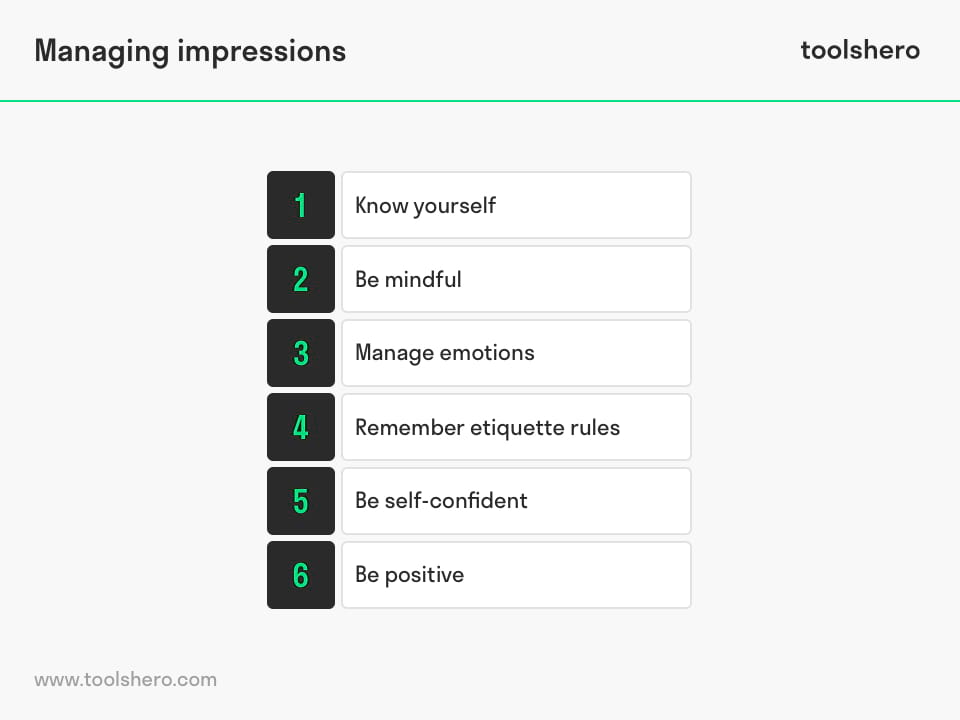Impression Management Theory by Erving Goffman

Impression Management Theory: this article provides a practical explanation of Impression Management, developed by Erving Goffman. The article starts with a general definition of Impression Management Theory, followed by supporting theories and the different techniques and methods associated with this discipline. You will also find practical tips to work on your own IM. Enjoy reading!
What is Impression Management (IM)? The theory and basics explained
The definition of Impression Management (IM), also called self-presentation, is that it is the conscious or subconscious process in which people attempt to influence others’ perception about a person, object or event by regulating and controlling information in social interactions.
Additionally, this theory elaborates on the fact that people must ensure that their perceptions and cognitions are consistent with goals and actions. Read more about cognitive dissonance in the consistency theory.
People will always present themselves as positively as possible to others (public image). Most people often wonder what others will think of them when they do, don’t do or say something. That’s no different in the business world. Take a company’s marketing activities, for example.
Salespeople will try their best to present their product or service as positively as possible, hoping for positive results. In fact, it’s their job to manage the impressions of the public and the potential consumer to maximise the results. A more everyday example is the boy who buys flashy new football shoes because he knows scouts will be coming to the match.
Impression Management theory
Impression Management was first conceptualised in 1959 by Erving Goffman. The work was first published in ‘The Presentation of Self in Everyday Life‘. The concept was expanded on in 1967.
Research into this subject was developed along two different pathways. One of these was aimed at factors that influence the kind of impressions people try to convey to others. The other path leads to eleven different presentation perspectives.
These perspectives include conformity, aggression, leadership, stigmatisation, and mental and physical health. This article discusses each of the eleven self-presentation techniques.
Impression Management Techniques and examples
Impression management refers to people’s attempts to control and influence the impression others have of them. There are approximately seven Impression Management techniques. These techniques are all used in daily life. At work, at home and during other occasions.

Figure 1 – Techniques in impression management
Conformity
Conformity means being accepted and is intended to let others enjoy the surroundings or the people in the surroundings. This technique is applied by companies when they have employees come together to work together and in doing so ensure that the employees feel accepted and comfortable.
Excuses
The second Impression Management technique concerns excuses. Excuses generally refer to a person’s explanation about a negative or unacceptable event.
This explanation is given to avoid a severe punishment or judgement. Excuses are often made. When being late for a meeting, or when a driver is fined for failing to wear his seatbelt.
Acclaim
Acclaim means proudly greeting the audience because someone knows he or she did their job perfectly. Someone does this with a sense of excellence about himself.
In the business world, this could refer to a project team member who is praised by the project manager because of a good idea or initiative. This encourages other employees to work harder and better.
Flattery
Flattery means excessively complimenting someone else to appear perceptive and likeable. Flattery is an assertive social technique for managing others’ impressions to increase one’s social attractiveness.
This is done by saying things that flatter, praise or compliment the other. This impression technique is especially common in the online marketing world.
Self-promotion
Self-promotion is about emphasising one’s best characteristics, or downplaying one’s shortcomings. This draws the attention to one’s own achievements. This phenomenon is particularly frequent in the business world.
An Impression Management example of this is a salesman who tells his boss: ‘colleague x has taken three years to reach the number of sales transactions I’ve concluded in six weeks.’
Favours
Favours is another popular technique, both in business and in everyday life. Favours are about doing something nice for others to receive acceptance and approval from them.
For instance, a salesman of luxury cars could offer his customer tickets to the theatre because he can’t use them himself.
Association
Association concerns improving or protecting one’s image by managing information about people and things with which one is associated.
For instance, an applicant could tell the interviewer: ‘that’s such a coincidence, your boss and I were roommates at university’. Association also means collaborating with others to strengthen and protect each other with regard to the information and image of the people involved in the association.
Impression Management and job interviews
People from a collectivist culture (Geert Hofstede’s dimensions) probably score higher on Impression Management. Additionally, higher scores on Impression Management are more frequent for selection assessments than for assessments aimed at development.
The same effect also occurs when someone has a new job. In that case, he or she tends to paint a more positive picture of themselves than when their looking for potential areas for self-development.
A high score is more often connected to the candidate when their applying for a commercial job. That seems logical. According to psychologist Jan Meijning, such a meeting is particularly about selling yourself.
Self-deception and Impression Management
Self-deception is a process or expression where relevance, meaning or importance of evidence and logical arguments are denied or rationalised. Self-deception entails that people convince themselves of a truth, so as not to reveal self-knowledge of the deception.
Everyone shows a certain level of self-deception. Too much of it, however, is problematic. Just try to explain to someone that they’re not listening, while they’re convinced they are listening. When someone isn’t aware of the unrealistic idea they have of themselves, it’s impossible to impress this upon them in a limited amount of time.
So, don’t try to do this during a job interview. When this does happen, the conversation will probably result in a yes-no discussion. Someone with an unrealistic self-image will even deny the results from a test report. Instead, asks for a candidate’s strengths, including examples.
How do you practice Impression Management
Below you can find several guidelines for managing the impressions you make on others.

Figure 2 – Managing impressions
Know yourself
Self-awareness is one of the most important things in successful IM and authenticity. Sociologist Erving Goffman proposed a dramaturgical theory in which he posited that human beings are merely a combination of various roles we adopt.
However, it’s important to have a sense of self-worth. Who am I? What do I value? What do I stand for? It’s important to have a sense of self-worth to prevent that we turn into a chameleon who adapts to everything and everyone around them. It’s not necessary to always go along with the masses.
Be mindful
When interacting with others, our brain works at full speed. In social situations, it’s important to be effective listeners and the points of view of others must be understood. For this purpose, lots of connections are made between different brain areas.
Although this often happens subconsciously, people should think about the consequences of statements and actions. Self-disclosure is an important part of forming relationships with others.
Yet, we should be careful not to reveal too much information too quickly and always think about how someone else would respond to this information.
Manage emotions
Nothing creates a negative impression faster than an inappropriate and explosive emotional outburst. Emotions are an important tool for connecting with others, and expressing emotions brings balance to the human brain, but emotions must be regulated and moderated.
Negative emotions such as anger, irritations or even disgust must always be carefully and strategically displayed.
For leaders in big organisations, for instance, it’s crucial to maintain emotional caution, but subtly let others know that they’re pleased or displeased.
Remember etiquette rules
There’s a set of social rules, also called norms, that tell people how to behave in specific social situations. To make and maintain a positive impression, it’s important to adhere to and respect these social norms.
Additionally, it’s important to show that we have good manners and know how to behave in different and perhaps challenging situations.
Being polite is always a good strategy for impression management, as few people disapprove of politeness or have negative associations with it.
Be self-confident
Self-confidence is difficult to adopt when you don’t have it, but there are social moments that demand courage and decisiveness. For instance, take a situation in which you’re obligated to converse with others. Take the initiative without thinking and ask a good question, or help someone.
Additionally, it’s important to stand up for your principles or convictions. It’s particularly important to convince others of your visions when you have a leadership position. Most people will respect your loyalty to a certain conviction or ideas. However, also be reasonable.
When someone else shares an argument that disproves your own conviction or work method, adjust these.
Be positive
There’s much to gain by looking at the importance and use of positive thinking and positive affection when making impressions. A smile, a compliment, a positive energy is always better than a negative and charged atmosphere. Optimistic leaders will be able to convince employees more easily and are more often seen as effective.
Effective self-impression management isn’t always easy. As with most social skills, this is also something that should be practised regularly to fully develop one’s self-impression management.
Impression Management: the summary
Impression Management is the process in which people try to influence the perceptions or impressions others have about them by regulating and controlling information. People tend to present a positive image of themselves to others. This also plays a role in the business world.
Various techniques are used for this purpose, either consciously or subconsciously. For instance, conformity, an excuse, acclaim or flattery. Additionally, self-promotion is popular, as are granting favours and association. People particularly try to display a positive image of themselves in job interviews. However, be careful of self-deception.
Read the tips in the section above to make sure you manage your own impressions correctly.
Now it’s your turn
What do you think? Do you recognise the explanation of Goffman’s impression management? Can you share a situation in which you used one of the impression management techniques mentioned above? Do you see people around you who use these techniques? Do you feel it’s a good thing to think about how others perceive you?
Share your experience and knowledge in the comments box below.
More information
- Goffman, E. (1959). The Presentation of Self in Everyday Life. Doubleday: New York, NY, USA, 1959.
- Bromley, D. B. (1993). Reputation, image and impression management. John Wiley & Sons.
- Leary, M. R., & Kowalski, R. M. (1990). Impression management: A literature review and two-component model. Psychological bulletin, 107(1), 34.
- Schlenker, B. R. (1980). Impression management. Monterey, CA: Brooks / Cole Publishing Company.
- Tedeschi, J. T. (Ed.). (2013). Impression management theory and social psychological research. Academic Press.
How to cite this article:
Janse, B. (2020). Impression Management Theory (Goffman). Retrieved [insert date] from Toolshero: https://www.toolshero.com/sociology/impression-management/
Original publication date: 06/03/2020 | Last update: 11/20/2023
Add a link to this page on your website:
<a href=”https://www.toolshero.com/sociology/impression-management/”>Toolshero: Impression Management Theory (Goffman)</a>












